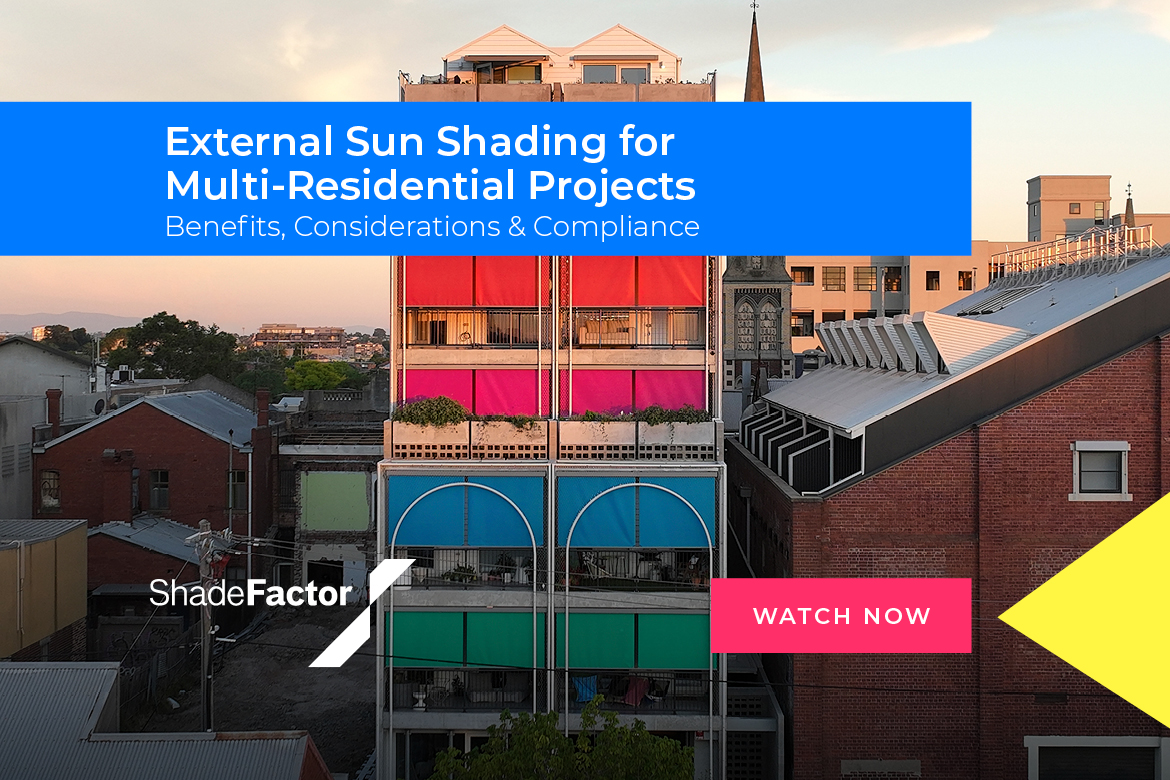External Sun Shading For Multi-Residential Projects – Benefits, Considerations & Compliance

When specifying shading systems for multi-residential applications, the considerations are many. Having considered their energy saving potential and decided on an external system, the next task is to decide which of these is best suited to your given application.
Given the range of products in this category includes everything from external venetian blinds, external vertical awnings, zip guided awnings and folding arm awnings to sliding shutters, louvres and more, this is anything but a simple choice.
That said, considering the importance of shading systems – not just in terms of aesthetic appeal, glare reduction, and shade provision – but also thermal efficiency, regulatory compliance and so on, it is also a choice worth getting right.
Titled ‘External sun shading systems for multi-residential buildings’, this CPD Live session is intended as a broad guide for specifiers considering systems of this type. It addresses all the issues involved in making an informed choice, and ensuring you end up with a shading system that is functional, compliant, and effective.
By the end of this session, you should be able to:
- Identify the various types of external shading systems that are suitable for multi-residential applications.
- Explain why specifying products of this type is not a one-size-fits-all proposition and identify the considerations involved in choosing the right one for a given project.
- Outline the variables involved in assessing the capacity of shading systems to improve the thermal efficiency of multi-residential buildings.
- Identify the various regulations – including those related to safety, fire prevention and sustainability – involved with installing external shading systems.
Speakers

Peter Skinner – Director, Shade Factor
Peter Skinner, founder and director of Shade Factor, brings a trained architectural perspective to the sun shading industry. With 25 years of experience, he has successfully led Shade Factor through numerous noteworthy projects, including several prominent towers in Sydney’s CBD and the current Martin Place metro development with Tzannes Architects.
Peter’s drawing and documentation background brings to Shade Factor a methodology centered around sketch exploration and the development of detailed solutions to sun shading requirements. This comprehensive approach delivers confidence to architects, builders and clients alike that their project has been considered from all angles.
Peter has passion for innovation and precision engineering, evidenced by the strong global and local partnerships he has forged; notably, his collaboration with Warema in Germany, one of the world’s largest sun shading manufacturers, provides Shade Factor with access to products that enhance Australian buildings. Additionally, these partnerships allow Peter and Shade Factor to remain at the forefront of sustainability knowledge, drawing inspiration from advanced markets and incorporating the latest sustainable practices into their work.

Mark Stranan – Associate, Austin Maynard Architects
Mark Stranan leads the multi-residential work at Austin Maynard Architects. His detail-orientated nature shines through in his work, which comes from a furniture making background. With over 15 years of experience in the sector, Mark’s recently completed projects include Terrace House, ParkLife & Slate House.
After completion in 2021, Terrace House has been awarded ArchDaily’s building of the year (housing), winner of a Sustainable Architecture Award from the Australian Institute of Architects Victoria 2022. ParkLife & Slate House are currently shortlisted in this year’s awards.
Recently named Architecture Studio of the Year by Dezeen, Austin Maynard Architects create resilient, highly sustainable, beautiful, robust and long lasting architecture. Architecture designed to meet the challenges of the climate crisis.

Horaci Sanchez – Associate Director, Six Degrees Architects
